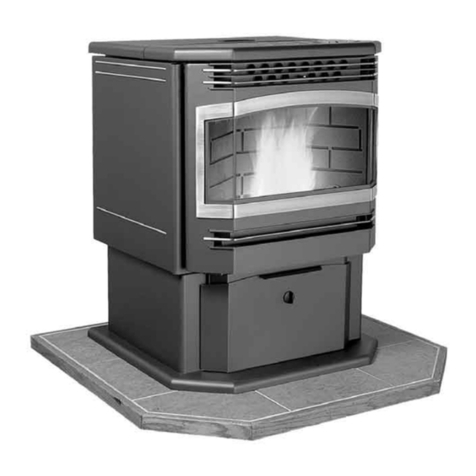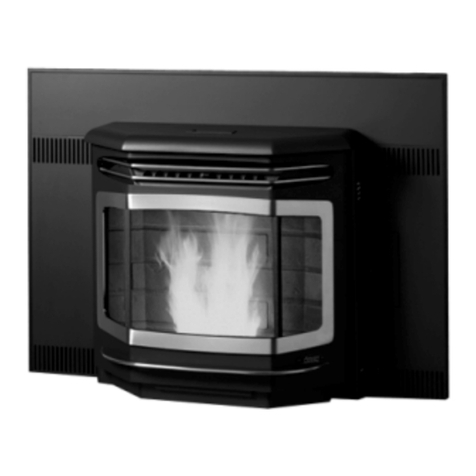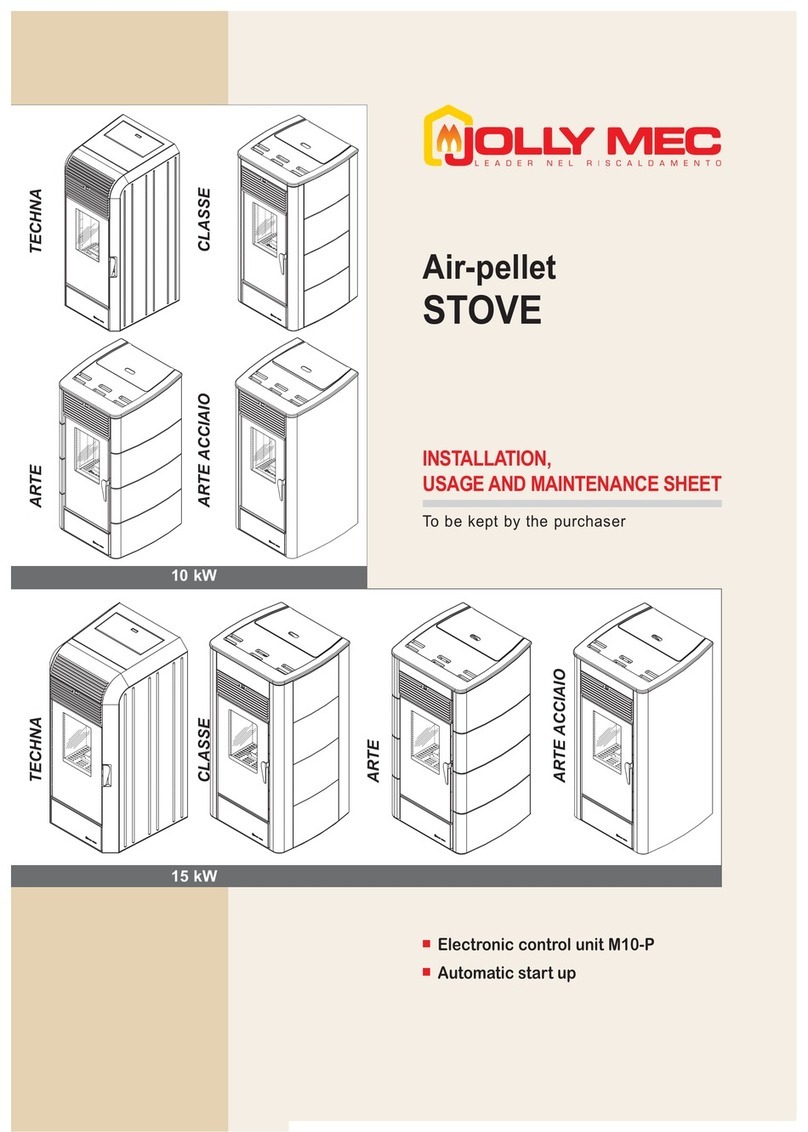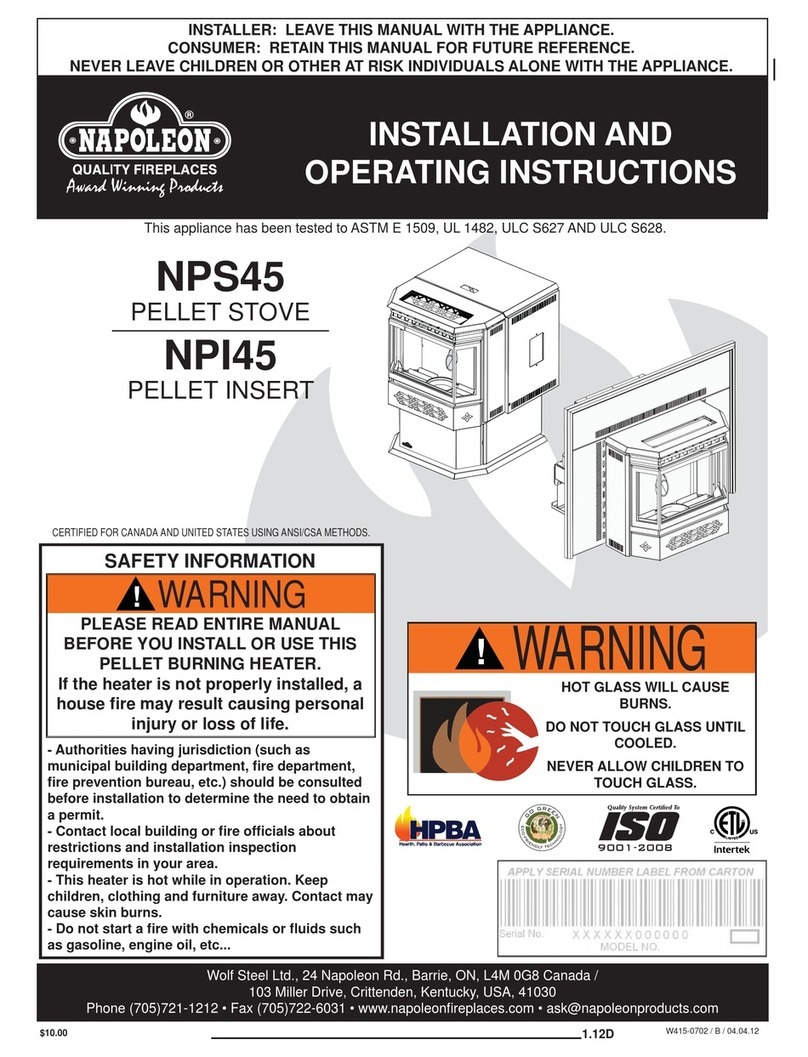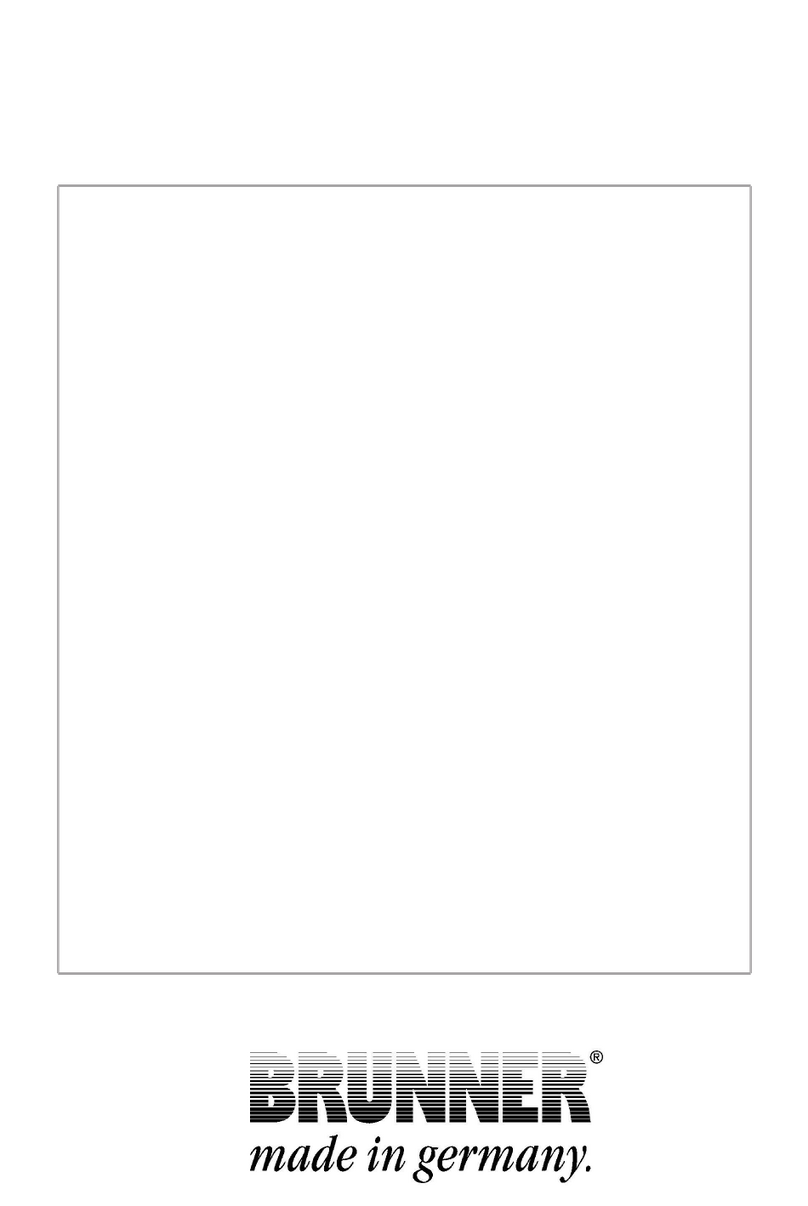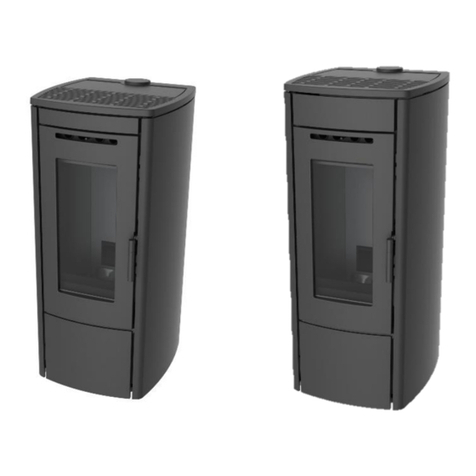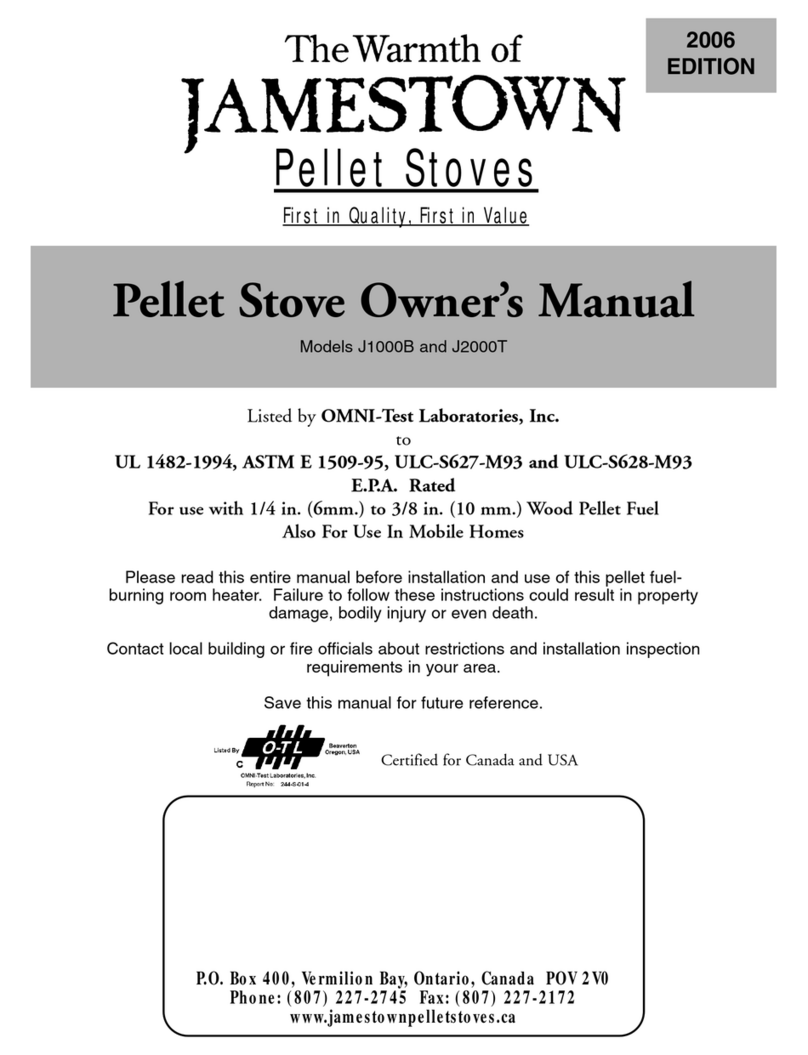Heta SCANDIA 6304 User manual

1
www.heta.dk
SCANDIA 6304
OPERATING INSTRUCTIONS
UK

2
Congratulations on your new stove.
We are sure that you will be happy
with your investment, especially if you
follow the advice and instructions we
have put together in these operating
instructions.
The Scandia 6304 has been approved
according to the EN 13240 / NS 3058.
Approval means that consumers can
be sure, that the stove meets a range
of specifications and requirements
INSTALLATION INSTRUCTIONS
2. Make sure there is adequate ventila-
tion to the room.
3. Please note that any extraction fans
operating in the same room as the
wood-burning stove can reduce the
chimney draft – which may have an
adverse effect on stove combustion
properties. In addition, this may
cause smoke to be emitted from
the stove when the firing door is
opened.
4. It must not be possible to cover any
air vents.
The floor
It is essential to ensure that the floor
surface can actually bear the weight
of the stove and a top-mounted steel
chimney, if applicable. The stove must
stand on a nonflammable surface such
as a steel floor plate or a brick or tile
floor. The size of the nonflammable
surface used to cover the floor area
must match national and local regula-
tions.
The chimney connection
The chimney opening must follow
national and local regulations. Howe-
ver, the area of the opening should
never be less than 175 cm2, which
corresponds to a diameter of 150 mm.
If a damper is fitted in the flue gas
pipe, there must always be at least 20
cm2of free passage, even when the
intended to ensure that the materials
used are of good quality, that the
stove does not adversely affect the
environment, and hat it is economical
to use.
With your new stove you should have
received the following:
a. Operating instructions
b. Guarantee slip
c. A stove glove
Safety clearances
Stoves must always be installed in line
with national and, if applicable, local
regulations. It is important to abide
by local regulations regarding setting
up chimneys and connection to same.
Therefore, always consult your local
chimney sweep before installation, as
you are personally responsible for en-
suring that the applicable regulations
have been met.
Distance regulations
A difference applies to installation
next to flammable and non-flammable
walls.
If the wall is made of non-flammable
material the stove can, in principle, be
placed flush against it. However, we
recommend leaving a gap of at least
5 cm to facilitate cleaning behind the
stove.
The minimum distances to flammable
material are stated on the boiler plate
and are listed in the table on page 4.
Warning
A stove gets hot. (In excess
of 90 degrees) Take care to
ensure that children and
elderly or infirm people can not come
into contact with it.
IMPORTANT
1. Make sure there is adequate provi-
sion to sweep the chimney.

3
damper is in its “closed” position. If
local regulations permit, two con-
tained fireplaces can be connected to
the same chimney. However, you must
abide by local regulations regarding
the distance between the two con-
nections. Wood-burning stoves must
never be connected to chimneys that
are also linked to a gasfired heater. An
efficient stove makes high demand on
chimney properties – so always have
your local chimney sweep evaluate
your chimney.
Connection to a brick chimney
Brick a thimble into the chimney and
seat the flue gas pipe in this. The
thimble and flue gas pipe must not
penetrate the chimney opening itself,
but must be flush with the inside
of the chimney duct. Joins between
brickwork, the thimble and flue gas
pipe must be sealed with fireproof
material and/or beading
Connection to a steel chimney
When fitting a connection from a top
-
output stove directly to a steel chim-
ney, we recommend fitting the chim-
ney tube inside the flue gas spigot so
that any soot and condensation drops
into the stove itself rather than collec-
ting on the exterior surface of the
stove.
For connections to chimneys that are
run through ceilings, all national and
local regulations regarding distance to
flammable material must be followed.
It is important that the chimney is
fitted with roof support so that the
top panel of the stove is not required
to bear the entire weight of the chim-
ney (excessive weight may damage the
stove).
Draft conditions
Poor draft may result in smoke being
emitted from the stove when the door
is opened. The minimum chimney
draft to ensure satisfactory combu-
stion in stoves of this kind is 12 PA.
However, there will still be a risk of
smoke emission if the firing door is
opened during powerful firing. The
flue gas temperature at nominal
output is 270°C when expelled to an
exterior temperature of 20°C. The flue
gas mass flow is 4.0 g/sec. The chimney
draft is generated by the difference
between the high temperature of the
chimney and the low temperature of
the fresh air. The length and insulation
of the chimney, wind and weather
conditions also have an effect on the
ability of the chimney to generate ap-
propriate under-pressure.
If the stove has not been used in a
while, check that the chimney and
stove are not blocked with soot, bird
nests, etc., before using it.
Reduced draft can occur when:
- The difference in temperature is too
small – due to insufficient chimney insu-
lation, for example.
- The outdoor temperature is too high
– in summer, for example.
- No wind is blowing. - The chimney is
too low and sheltered. - The chimney
contains false air.
- The chimney and flue gas pipe are
blocked.
- The house is too airtight (i.e. when
there is an insufficient supply of fresh
air).
- Poor smoke extraction (poor draft
conditions) due to a cold chimney
or bad weather conditions can be
compensated for by increasing the
airflow into the stove.
Good draft occurs when:
- The difference in temperature bet-
ween the chimney and outdoor air
is high.
- The weather is fine. - The wind is
blowing strongly.
- The chimney is of the correct height:
at least 4.00 m above the stove and
free of the roof ridge.

4
Instructions for use
appropriate length (approx. 22–30 cm)
so that they can lie flat on the bed of
embers. If you store your wood outdo-
ors, it is best to cover it.
Examples of fuel values of different
woods
Fuel type / number of cubic metres per
1,000 litres of oil
Oak
Beech
Ash Birch Elm
Common
spruce
7,0 7,0 7,2 8,0 8,9 10,4
Chimney fires
In the event of a chimney fire – which
often results from incorrect operation
or protracted firing with moist wood
– close the door and shut off the se-
condary/start-up air supply to smother
the fire. Call the fire department.
Regulating the airflow
Primary airflow is added using the pri-
mary airflow control on the door (Fig.
1) and secondary airflow using the
handle above the door (Fig. 2).
Turning the handle fully to the left or
right closes or opens the secondary
airflow.
The primary airflow is opened by
turning the control located on the ash
collector door (see Fig. 1) by 180º.
Turning the control a further 180º will
close the primary airflow.
Fig. 1
Open
Closed
First firing
The stove has been treated with a heat-
resistant coating which hardens at a
temperature of approximately 250
ºC. This hardening process causes the
production of smoke and malodorous
fumes, so the room must be very well
ventilated.
During the first firing, which should
be carried out using approximatly 1,6
kg. of wood, the stoking door must
be left slightly open and must not be
closed until the stove is cold. This is to
prevent the sealing rope sticking to
the stove.
Fuel
Your new stove is EN approved for
firing with wood fuel. You must there-
fore only burn clean, dry wood in your
stove. Never use your stove to
burn
driftwood, as this may contain a lot
of salt which can damage both the
stove and the chimney. Similarly, you
must not fire your stove with refuse,
painted wood, pressure-impregnated
wood or chipboard, as these materials
can emit poisonous fumes and smoke.
Correct firing using well seasoned wood
provides optimal heat output
and maxi-
mum economy. At the same time,
correct firing prevents environmental
damage in the form of smoke and em-
missions and also reduces the risk of
chimney fires.
If the wood is wet and inadequately
seasoned, a large proportion of the
energy in the fuel will be used to
vaporise the water, and this will all
disappear up the chimney. Thus it is
important to use dry, well seasoned
wood, i.e. wood with a moisture
content of no more than 18%. This is
achieved by storing the wood for 1–2
years before use. Pieces of firewood
with a diameter of more than 10 cm
should be split before storing. The
pieces of firewood
should be of an

5
Lighting
To ignite the fuel, use fire lighters,
small paraffin ignition bags or small
pieces of wood placed on the bottom
grate. Place larger pieces of wood on
top of this kindling material, at right
angles to the firing, doors. Complet-
ely open the secondary air supply and
leave the firing door ajar – i.e. approx.
1 cm open. Once the fire has taken a
good hold of the fuel and the chimney
has heated up (after about 10 min)
close the firing door. We recommend
that you burn the entire first firing
with the secondary air supply fully
open to make sure that the chimney is
thoroughly heated.
Refiring
You should normally refire the stove
while there is still a good layer of
embers. Distribute the embers across
the bottom grate, place pieces of
fuel (max. 1,5 kg) on the embers in
a single layer perpendicular to the
firing opening. Close the firing door
and use primary air if needed. The
wood will then ignite very quickly
(within 30 to 60 seconds). When the
wood is burning with a steady flame,
close the primary airflow. Then adjust
the secondary airflow to the required
amount. For nominal operation (4
kW), the secondary airflow should be
fully open and the primary airflow
closed. When firing, take care not to
pack the fuel too closely together, as
this will result in poor and inefficient
combustion. Please note that the
primary airflow must be closed during
normal operation, otherwise the stove
may overheat. It must only be used
until the fuel is burning with a steady
flame.a steady flame.
Reduced burning
The stove is well-suited to intermittent
use. If you wish to operate the stove
with reduced out-put, simply insert
smaller volumes of wood at each firing,
and apply a lower airflow. However,
remember that the secondary combu-
stion air supply must never be shut off
completely during firing. It is impor-
tant to keep a good bed of embers.
Gentle heat is released when the fire
settles - i.e. when the wood no longer
generates flames and has been conver-
ted to glowing embers.
Optimal firing
To achieve optimal firing and the
highest possible effect, it is important
to make sure that the air supply is
used
correctly. As a general rule, the
secondary
air is to be used to control
the fire to ignite the flue gases. This
produces a high effect and keeps the
glass panel completely clear of soot
as the secondary air “washes” down
over it. Please note that the stove will,
naturally, produce soot if both the
primary- and secondary air intakes are
closed completely. This will prevent
oxygen from being drawn into the
stove, and the viewing window and
other parts will become covered with
soot. If this situation is combined with
firing with wet wood, the build-up of
soot can become so thick and sticky
that the sealing rope can, for example,
become detached when the door is
opened the next day.
Risk of explosion
After you add new fuel, it is
very important that you do
not leave the stove unatten-
ded until the wood is burning con-
stantly. This will normally occur within
30 to 60 seconds.
A risk of explosion can possibly arise if
too much wood is placed in the stove.
Open Closed
Fig. 2

6
This may result in the production of
large volumes of gas, and this gas can
explode if the intake of primary and
secondary air is insufficient.
It is an advantage always to leave
some ash lying in the bottom of the
combustion chamber.
Take care when emptying the ash pan,
as cinders can continue to burn in the
ash for long periods of time.
OPERATIONAL PROBLEMS
regulate the draft. When cleaning the
chimney, soot and other deposits may
come to fall on the smoke plate. In ca-
ses where the wood burns too quickly,
this may be due to excessive chimney
draught. You should also check to
make sure that the door seal and ash-
pan seal is intact and correctly fitting.
If the stove it generating too little
heat, this may be because you are fi-
ring with wet wood. In this case, much
of the heating energy is used to dry
the wood, resulting in poor heating
economics and an increased risk of
soot deposits in the chimney.
MAINTENANCE
The surface of the stove has been tre-
ated with heat-resistant paint.
The stove should be cleaned with a
damp cloth. Any damage to the surface
in the form of chips or scratches
can
be repaired using touch-up paint,
which is available in spray cans. If the
stove has become grey in colour due
to overheating, touch-up paint of this
kind can be used to repaint the stove
entirely. However, in this case, the
Stove
type
Scandia
Nominal
fluegas
temp.
c°
Smoke
stub
mm
Fuel
volume
kg
Draught
min
mbar
Nominal
output
tested
kW
Heat
output
kW
Distance to flamma-
ble
materials in mm
behind at the
the stove sides
Distance to
tfurnitures
from the
stove in mm
Stove
weight
kg
6304 270 ø120 1,0 0,12 4 4 330 450 1650 55
The nominal output is the output to which the stove has been tested.
Testing should be carried out
with the primary airflow closed and the secondary airflow fully open.
Stove data table in accordance with EN 13240 testing.
The chimney must be swept at least
once a year, we recommend the use of
a NACS (national association of chim-
ney sweeps) registered chimney sweep.
In the event of smoke or malodorous
fumes being produced, you must first
check to see whether the chimney is
blocked. The chimney must, of course,
always provide the minimum draught
necessary to ensure that it is possi-
ble to regulate the fire. Please note,
however, that chimney draft is depen-
dent on the weather conditions. In
high winds, the draft can become so
powerful that it may be necessary to
fit a damper in the flue gas pipe to
stove should be dismantled and the
surface treatment should be performed
outdoors or in a purpose-built room.
Cleaning the glass
Incorrect firing, for example using
wet wood, can result in the viewing
window becoming covered in soot.
This soot can be easily and effectively
removed by using proprietary stove
glass cleaner.

7
Emptying the ash pan. Fig. 3 og 4.
Fig. 3 Fig. 4
Cleaning after sweeping the chimney and replacing the
stones. Fig. 5 - 8.
Fig. 7
Fig. 5
Fig. 8
Fig. 6

8
Warning
Any unauthorised modifica-
tion of the stove and any use
of non-original spares will
void the guarantee.
GUARANTEE
The model Scandia 6304 stoves are
subjected to stringent quality con-
trol procedures both throughout the
production process and immediately
before delivery to the dealer.
Therefore, the stoves are guaranteed
against defects in manufacturing
FOR FIVE YEARS.
This guarantee does not cover:
Wearing parts/fragile parts such as:
• The re-proof bricks in the
combustion chamber.
• The smoke bafe.
• The glass.
• The sealing rope.
• The grate frame.
Damage resulting from incorrect use
Transport costs in connection with
repairs carried out under guarantee
Installation/disassembly in connection
with repairs carried out under guaran-
tee. Should you have cause to make
a complaint, please quote our invoice
no.
Changing to back smoke outlet Fig. 9 - 12
Fig. 9 Fig. 10 Fig. 11
Fig. 12
27-05-2009 0037-1206
Table of contents
Other Heta Pellet Stove manuals
Popular Pellet Stove manuals by other brands

HearthStone
HearthStone 8330 owner's manual

Euroheat
Euroheat EVO AQUA 9 operating instructions

Lopi
Lopi Foxfire manual

Quadra-Fire
Quadra-Fire MTVERNINSAE-MBK owner's manual

Palazzetti
Palazzetti ECOFIRE AIR SLIM 7 DESCRIPTION / CLEANING / TECHNICAL DATA
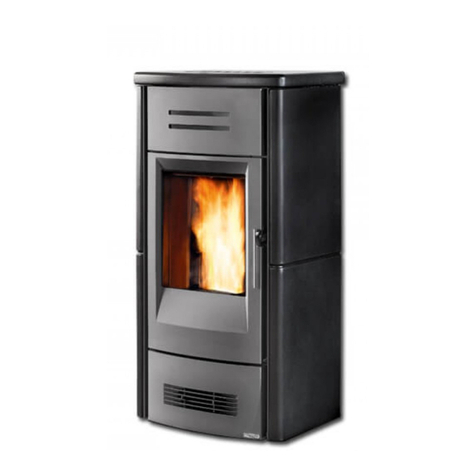
Piazzetta
Piazzetta P963 THERMO Instructions for installation, use and maintenance


